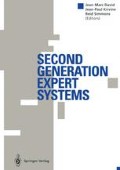Abstract
The systems-model-operator perspective provides a unifying perspective for the ways that expert systems represent, organize, and apply knowledge representations. We use this metaphor to develop Topo, an expert system for configuration of computer networks. Generalizing Topo, we show that its modeling language and operators can be adapted to other tasks that require relating a physical/organizational structure to a service-supply network. This experiment demonstrates how expert systems can be generalized and more easily related to each other if we express control knowledge in terms of operators for constructing system models.
Access this chapter
Tax calculation will be finalised at checkout
Purchases are for personal use only
Preview
Unable to display preview. Download preview PDF.
References
Chandrasekaran, B.: “Expert systems: Matching techniques to tasks,” in AI Applications for Business, W. Reitman, ed., Ablex Publishing, Norwood, NJ, (1984) 116–132.
Clancey, W. J.: Heuristic classification, Artificial Intelligence 27 (1985) 289–350.
Clancey, W. J.: Model Construction Operators, Artificial Intelligence 53 (1992) 1–115.
Hayes-Roth, B., Hewett, M., Vaughan Johnson, M., and Garvey, A.: “ACCORD: A Framework for a Class of Design Tasks,” Tech. Report KSL-88-19, Stanford Univ., Palo Alto, CA (1988).
Marcus, S.: Automating Knowledge Acquisition for Expert Systems, Kluwer Academic Publishers, (1988).
McDermott, J.: “Preliminary steps toward a taxonomy of problem-solving methods,” in Automating Knowledge Acquisition for Expert Systems, S. Marcus, ed., Kluwer Academic Publishers, Norwood, MA (1988) 225–256.
McDermott, J.: R1: A rule-based configurer of computer systems, Artificial Intelligence 19 (1982) 39–88.
Musen, M.: Automated support for building and extending expert models, Machine Learning 4 (1989) 347–377.
Thompson, T. and Clancey, W.J.: A qualitative modeling shell for process diagnosis, IEEE Software 3 (1986) 6–15.
van Melle, W.: A Domain-Independent System that Aids in Constructing Knowledge-Based Consultation Pprograms, doctoral dissertation, Stanford Univ., Computer Science Department, Palo Alto, CA, 1980.
Author information
Authors and Affiliations
Editor information
Editors and Affiliations
Rights and permissions
Copyright information
© 1993 Springer-Verlag Berlin Heidelberg
About this paper
Cite this paper
Clancey, W.J., Barbanson, M. (1993). Using the System-Model-Operator Metaphor for Knowledge Acquisition. In: David, JM., Krivine, JP., Simmons, R. (eds) Second Generation Expert Systems. Springer, Berlin, Heidelberg. https://doi.org/10.1007/978-3-642-77927-5_20
Download citation
DOI: https://doi.org/10.1007/978-3-642-77927-5_20
Publisher Name: Springer, Berlin, Heidelberg
Print ISBN: 978-3-642-77929-9
Online ISBN: 978-3-642-77927-5
eBook Packages: Springer Book Archive

